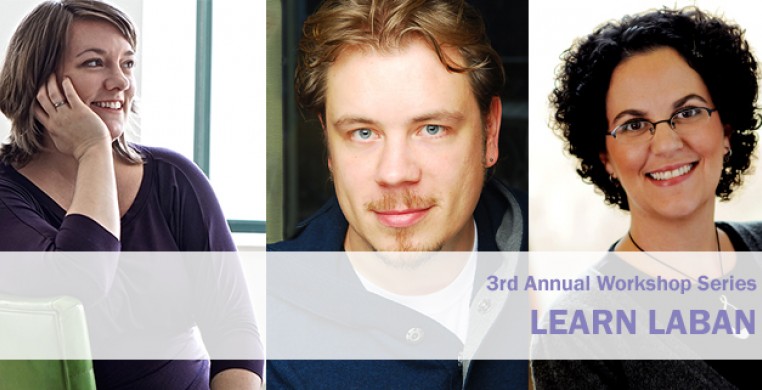Learn Laban presents various facets of Rudolf Laban's taxonomy, such as Body, Effort, Shape, and Space and their numerous applications to dance, theater, creative arts therapies, and more.
At the end of each workshop session, participants will:
- have a basic understanding of the LMA topic being addressed in the workshop session (Body, Effort, Shape, Space, etc.)
- be able to embody concepts taught in the workshop
- be able to apply this topic to their area of expertise.
Participants should be enrolled in undergraduate studies or already have a BA degree.
Foray into Fundamentals with Kristina Fluty, 10:00AM-12:00PM
In the world of Laban Movement Analysis, the work of Irmgard Bartenieff is considered to be a groundbreaking contribution to Laban’s legendary system of observing, notating, and analyzing human movement. In this workshop, we will explore the concepts of Bartenieff Fundamentals (including the Basic Six exercises) using full-bodied movement through space. Learn how integrated understanding and execution of developmental movement patterns, complex gradated rotation, dynamic intention, and clarity of spatial pathways all add up to a more delicious movement experience. No matter how you relate to this material—as a dancer, an actor, a philosopher, a scientist, or however you appreciate embodied connectivity—you will come away with an increased understanding of your moving body. In addition to a plethora of physical endeavors, this 2-hour workshop will include some time for discussion and other modes of processing the information learned through moving.
Kristina Fluty (MA, GL-CMA, and MPAC, Columbia College Chicago, Department of Creative Arts Therapies) has been teaching in the Laban Movement Analysis Certification program at Columbia since 2009. She enjoys a prolific teaching and performing life in and around Chicago, and is celebrating her 12th year as a movement collaborator with Molly Shanahan/Mad Shak. Her BA in Dance is from Point Park University in Pittsburgh, PA, where she frequently returns to teach and choreograph. She is also an adjunct faculty member at The Theatre School of DePaul University, and has been adjunct faculty at The University of Chicago. . Kristina recently started Kinespark Consulting as a home for her analysis and movement coaching services. Check it out at www.kinespark.com.
Deepened Dynamics with Paul Holmquist, 1:00PM-3:00PM
The performing arts rely on the efficacy of gesture and movement to communicate mood and inner energy. Rudolf Laban, a pioneer in the study of movement, used the word Effort to describe this dynamic quality in human expression. We will study the range of expression in attitudes towards Weight, Space, Time and Flow in various combinations and explore the deeper sensations of performing them that help us make meaning of movement. Learn about your preferences and prejudices about movement qualities and how modulation can work to find a new approach to your own work. Actors and directors, dancers and choreographers, singers and musicians, performing artists of all kinds, can deepen their connection to the dynamics of their work.
Paul S. Holmquist is a graduate of the Theatre School at DePaul University (BFA, Acting) and has worked as an actor and director in the Chicago community for 15 years. An Ensemble member of Lifeline Theatre and Artistic Associate of the Griffin Theatre, his work has earned dozens of award nominations and garnered extensive critical acclaim. After acquiring the Graduate Laban Certificate in Movement Analysis from Columbia College Chicago in 2005, Paul uses a movement based approach to staging and directing as well as in his personal acting process. He now teaches in the Graduate Laban Certificate in Movement Analysis (GL-CMA) program at Columbia College Chicago and has guest lectured in Roosevelt University’s theatre department.
Exploration of Space Harmony with Stacey Hurst, 3:30PM-5:30PM
Get a taste of Rudolf Laban’s theory of Space Harmony and learn how you can clarify your movement by increasing spatial awareness. Through the use of crystalline forms we will map out the space surrounding our bodies to facilitate more organized, functional and expressive movement paths. You will also find maximum stabilizing and mobilizing forces by moving through the various spatial tensions found within these forms. Whether a dancer, actor, teacher, choreographer, director or body-oriented clinician you will be able to apply Laban’s theory to your work.
Stacey Hurst is a dance/movement therapist, licensed clinical professional counselor and graduate Laban certified movement analyst. She has taught Laban Movement Analysis (LMA) for the past 16 years as a part-time faculty member at Columbia College Chicago in the Department of Creative Arts Therapies. Guest lecturing experience includes: Roosevelt University’s theatre department, Aurora University’s psychology department, and Tanter Dance Movement Therapy Association Prague, Czech Republic. She is a consistent presenter at the American Dance Therapy Association’s annual conference and sits on the Dance/Movement Therapy Certification Board. Last year Stacey was awarded a Cross-Collaboration Fellowship Grant to combine efforts with a theatre faculty and create an enhanced learning environment for the students at Columbia College Chicago based on LMA. She has a full time private practice in Warrenville where she counsels individuals to achieve optimal health—body, mind, and spirit:

